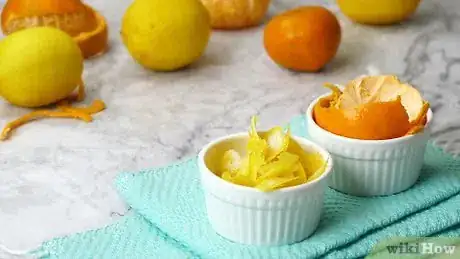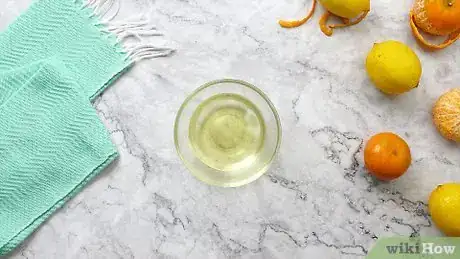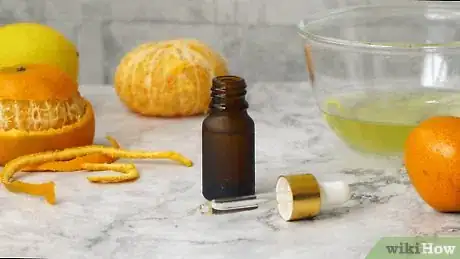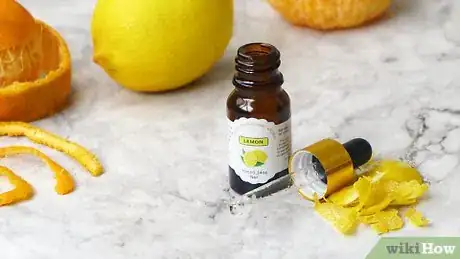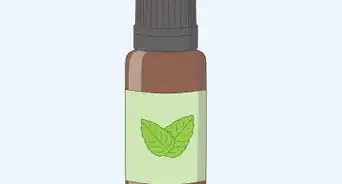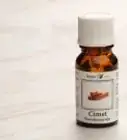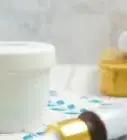This article was co-authored by Ritu Thakur, MA. Ritu Thakur is a healthcare consultant in Delhi, India, with over 10 years of experience in Ayurveda, Naturopathy, Yoga, and Holistic Care. She received her Bachelor Degree in Medicine (BAMS) in 2009 from BU University, Bhopal followed by her Master's in Health Care in 2011 from Apollo Institute of Health Care Management, Hyderabad.
wikiHow marks an article as reader-approved once it receives enough positive feedback. This article received 12 testimonials and 80% of readers who voted found it helpful, earning it our reader-approved status.
This article has been viewed 311,575 times.
Essential oils are great for freshening up before heading out for the day, bringing a pleasant citrus scent to the home, and can be used in a variety of cooking or craft recipes. Making your own essential oil can be done easily at home, with just a few ingredients found around the home.
Steps
Using Cold Pressing
-
1Wash the materials and peel the fruit. Wash your hands and the fruit you will be extracting oil from. Cold pressing doesn’t involve chemicals for extraction, so it’s important to thoroughly wash the fruit to remove bacteria. Remove the rind of the fruit with a peeler or knife and place it to the side. You may also remove the rind of the fruit with your fingers if you desire, but this can cause a greater amount of pulp and other fruit material to end up in the oils, which will need to be removed later.
- The greatest concentration of oils in most fruit is contained in the outer layer of the rind. The lighter portion of the rind contains much less oil.[1]
- You can use an electric peeler to obtain the skin of the fruit, but note that this may produce more pulp than a hand peeled method.
-
2Reuse the leftover peels. Once the fruit is peeled, you can use the leftover fruit for cooking or eating. There are a variety of uses for the leftover fruit peel, even after pressing. Rather than composting the peel, try:
- Keeping the peels in a small bag and hanging it somewhere to keep the room smelling zesty.
- The oil in orange peel, limonene, acts as a repellant for several types of insects.
- Toss a few peels into the garbage disposal and give them a good grinding to freshen up the smell of your sink.[2]
Advertisement -
3Press the fruit peel. Use a pressing device, such as a sieve, to squeeze the fruit peel over a jar. Heavy pressure will squeeze liquid from the peel - this liquid contains the oils you're looking for. Use a fair amount of strength when pressing, but take care not to damage or break the implement you are using. You should see a small amount of oil drain from the peel after a few seconds.
- Cold pressing peel is quite a bit of effort for what looks to be a fairly small amount of oil. Don’t get discouraged. The oil is quite potent.
- A garlic press is a great way of pressing small amounts of fruit peel with ease. A mortar and pestle may also be used, though this method is a little more labor intensive and difficult.
-
4Separate the oils. Allow the liquid squeezed from the peel to stand for a few days. The oil will separate from the rest of the liquid, which can then be collected. A centrifuge can also be used to separate the oil from the rest of the liquid!
- A simple way of collecting the oil from the liquid is placing the liquid in the freezer. The oil will remain in its liquid form while the remainder freezes, allowing you to pour out the oil.[3]
- Oil extracted this way has a small shelf life. Try to use any oil created within a 6 month period.
-
5Apply when needed. Bottle the oil that you extract from the liquid for later use. Dab a little on your skin for a fresh smell, or use some in cooking recipes that require essential oil. Remember that the oil is very concentrate – a little will go a long way.
Distilling Essential
-
1Peel your fruit and lay the rinds out to dry. Allow them to air dry until the peels are hard to the touch. This can take anywhere from a few days to up to a week, so remain patient.
- Avoid the use of a dehydrator or other drying mechanisms when drying the peels. This can compromise the oil stored in the peels.
-
2Cut the peels into small pieces. Once the peels are completely dry, cut the peels into small pieces. You can use a knife, vegetable dicer, or food processor to accomplish this. Take care not to over dice or process the peels however, as this can compromise the oils contained in the peels.
- Over diced peels will take on a liquid, minced appearance. Avoid expressing liquid from the peels prior to the distillation process.
-
3Place the peels in a jar and cover with grain alcohol. Pour enough alcohol into the jar to completely cover the peels. The alcohol should rest roughly an inch above the top of where the peels rest. Allow the jar to sit in the sun for 3 to 4 days.
- Vodka can be used for the distilling process, but may slightly affect the scent of the oil, depending on the type of vodka used.
- Place the jar in a location that gets plenty of sunlight to help the separation process.
- Shake the jar several times a day. Give the jar a shake each day to help separate the oil from the peels.
-
4Strain the liquid from the peels. After several days have passed, use a coffee filter to strain the liquid into a second jar. Place a coffee filter or cloth over the second jar, and allow all of the alcohol in the jar to evaporate. This can take up to a week or more.[4]
- Oil evaporates much more slowly than water or similar types of liquids. Though oil can technically evaporate, the water will evaporate before the oil, leaving just the oil behind.
-
5Apply when needed. After the alcohol has evaporated, all that will remain is the oil. Bottle the oil for later use. Dab a little on your skin for a fresh smell, or use some in cooking recipes that require essential oil. Remember that the oil is very concentrate – a little will go a long way.
- Always test a small amount on your skin first in case you have a reaction to the peel oil.
- Skin sprayed with citrus oil should not be exposed to direct sunlight. Citrus oil is phototoxic, meaning direct sunlight can contribute to sunburn, blisters and other harmful skin conditions.
Things You'll Need
- Citrus fruit
- Fruit peeler
- Knife and cutting board
- Jar
- Sieve
- Grain alcohol
- Garlic press (optional)
References
- ↑ https://www.jbtc.com/-/media/files/foodtech/solutions/citrus-processing/citrus-peel-oil-recovery-manual.ashx
- ↑ http://www.greenlivingtips.com/articles/orange-peel-tips.html
- ↑ http://www.veganbaking.net/articles/tools/fat-and-oil-melt-point-temperatures
- ↑ http://www.condoblues.com/2011/04/how-to-make-orange-essential-oil-from.html
About This Article
To extract oil from fruit peels by cold pressing, start by washing the fruit thoroughly to remove bacteria. Next, remove the rind of the fruit with a peeler or knife. Then, use a pressing device, such as a sieve or garlic press, to squeeze the fruit peel over a jar until you see liquid drain from the peel. Allow the liquid to stand for a few days until the oil separates from the rest of the liquid, then collect the oil! For tips on collecting the separated oil from the rest of the liquid, read on!

